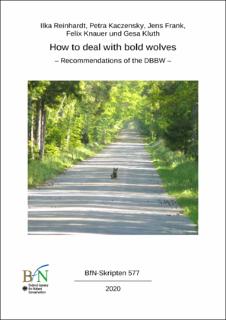| dc.description.abstract | For a long time, there were no wolves in Germany. Since 2000, the species has been steadily spreading out from Lusatia and populating more areas. People in areas recently settled by wolves are only gradually learning how to live alongside this animal and are often uncertain how to interpret wolf behaviour. How dangerous are wolves for humans? What constitutes normal behaviour and what is considered unusual or bold behaviour? This report provides assessments of wolf behaviour as it relates to human safety and recom-mends managing wolves which display unwanted behaviour. In this report, conspicuous behaviour refers to wolf behaviour towards humans which is considered undesirable, and ranges from unusual to bold. This report is intended to provide guidance and recommendations to the authorities respon-sible for wolf management, and focusses on wolf-human interactions. It defines terms frequently used in this context, summarises the current state of knowledge relating to the danger posed by wolves and describes the causes for the development of bold behaviour. Recommendations on how to react to reports of bold wolf sightings are also given. Moreover, the report assesses the most common types of wolf behaviour in relation to human safety. These recommendations are primarily aimed at the competent federal state authorities, to enable them to make an initial assessment of wolf behaviour in terms of human safety and to prepare possible courses of action. However, it is not intended as a general template for action. Every situation in which a wolf is perceived as bold or is behaving conspicuously needs to be assessed on a case-by-case basis. The aims of these recommendations are a) to ensure that people in Germany are not injured or killed by wild wolves; b) to foster and maintain public trust in wolf management authorities in wolf regions; c) to ensure that people’s fear of wolves does not increase and d) to enable wolves to spread further in Germany without causing serious conflicts between wolves and humans. | en_US |
